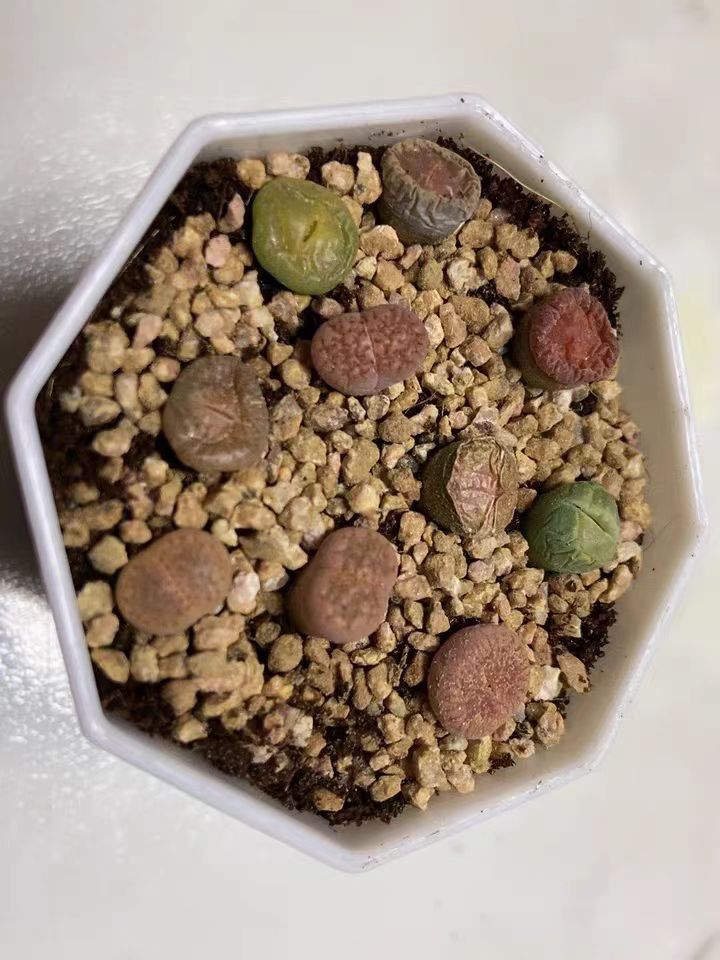Lithops is a particularly interesting succulent plant. It looks like small pebbles, so people also call it "stone flower" or "butt flower". It has a unique shape and rich leaf colors, and many friends who like to grow succulents can't put it down. Today, I will talk in detail about how to propagate Lithops.
If you want to grow more Lithops, the most commonly used method is sowing propagation, which is especially suitable for those who want to cultivate them in batches. The sowing time is crucial. Spring (April to May) or autumn (September to October) is a good time. At this time, the temperature is stable at 15-25°C, and the seeds are more likely to germinate.
When preparing for sowing, first find a flower pot with good air permeability. Both ceramic pots and plastic pots are fine, and there should be drainage holes at the bottom of the pot. For the soil, you can mix peat soil, perlite, and vermiculite in a ratio of 1:1:1. Remember to disinfect the soil before use, such as by steaming it at high temperature or adding some carbendazim to kill the germs and insect eggs in the soil.
The seeds should be purchased from regular channels to ensure their quality. When sowing, fill the flower pot with the prepared soil and gently compact it. Use a spray bottle to moisten the soil surface. Since the seeds are very small and you are afraid of sowing them too densely, you can mix them with a small amount of fine sand and then evenly sprinkle them on the soil surface. There is no need to cover them with soil. Then cover the flower pot with a layer of transparent glass or plastic film to maintain humidity and temperature.
After that, place the flower pot in a warm and bright place without direct sunlight. Open the cover for ventilation for 10-15 minutes every day to prevent the seeds from getting moldy. The seeds will germinate in about 7-10 days. During this period, keep the soil moist but without waterlogging. When the seedlings have 2-3 true leaves, you can slowly uncover the covering, let them receive more light, and at the same time separate the overly dense seedlings to give each plant enough space to grow.
If the Lithops in your home have grown into clusters, division propagation is a good choice, and you can quickly get new plants. It is best to divide them in spring (March to April) when the plants are just starting to grow and have strong recovery ability. When operating, carefully take out the whole Lithops plant from the flower pot, gently shake off the soil on the roots, being careful not to damage the roots. Then use a sharp knife to divide the plant into several small clusters, with at least 1-2 growing points and complete roots in each cluster. After dividing, apply some carbendazim to the cut wounds to prevent infection, and place them in a cool and ventilated place to air-dry for 1-2 days. Repot them after the wounds have healed. Choose a flower pot of the right size, and the soil can be the same as that used for sowing. After planting, water thoroughly and place it in a cool and ventilated place for a week to let the seedlings recover. Then move it to a place with sufficient light for normal cultivation.
There is also a method of cuttings propagation. However, since the leaves of Lithops are relatively thin, the survival rate of cuttings is relatively low, and you can give it a try. When the temperature is appropriate in spring and autumn, select healthy leaves without diseases and pests, cut them off with scissors, and place them in a cool place to air-dry for 1-2 days. When the wounds are dry, place the leaves flat on the surface of the moist substrate, making the base of the leaves contact the substrate. There is no need to insert them into the soil. Then place the flower pot in a warm and bright place without direct light, keep the substrate moist but not waterlogged. In about 2-3 weeks, the leaves will take root and sprout. When the new shoots grow into complete plants, they can be transplanted.
In short, when propagating Lithops, you can choose the methods of sowing, division, or cuttings according to your own situation. Pay more attention to aspects such as light, temperature, water, soil, fertilization, and ventilation during maintenance to create a suitable growth environment for it, so that Lithops can show its unique charm and grow beautifully and healthily.
How to propagate Lithops succulents?

Share with
Tagged in :




Leave a Reply